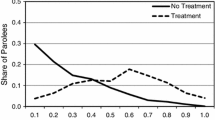Abstract
The parole performance of offenders who were released after successfully completing a shock incarceration program was examined and compared to the performance of offenders who were serving time on probation or parole after a period of incarceration. Separate survival analyses were performed for recidivism as measured by (1) arrests and (2) failures (jailed, absconded, or revoked). Prior incarceration, age, age at first arrest, and risk assessment score were related to recidivism but type of sentence was not. Intensity of supervision was significantly related to recidivism but this relationship was eliminated when risk level was controlled. There was no evidence that shock incarceration reduces recidivism. Future research should focus on methods of reducing failures during community supervision for these young, nonviolent offenders within the framework of either a shock incarceration program or some other sentence.
Similar content being viewed by others
References
Allison, P. D. (1984).Event History Analysis, Sage, Beverly Hills, Calif.
Boudouris, J., and Turnbull, B. W. (1985). Shock probation in Iowa.Offender Counsel. Serv. Rehab. 9: 53–67.
Cox, D. R., and Oakes, D. (1984).Analysis of Survival Data, Chapman and Hall, New York.
Greenfield, L. A. (1985).Examining Recidivism, Bureau of Justice Statistics Special Report, U.S. Department of Justice, Washington, D.C.
Harrell, F. E., Jr. (1986). The PHGLM procedure.SUGI Supplemental Library User's Guide, SAS Institute, Inc., Cary, N.C.
Kalbfleisch, J. D., and Prentice, R. L. (1980).The Statistical Analysis of Failure Time Data, John Wiley, New York.
Louisiana Department of Public Safety and Corrections (1987).IMPACT: Purposes, Policies and Procedures, LDPSC, Baton Rouge, La.
MacKenzie, D. L., and Ballow, D. B. (1989). Shock incarceration programs in state correctional jurisdictions-An update.Natl. Inst. Just. Rep. 214: 9–10.
MacKenzie, D. L., and Parent, D. G. (1991). Shock incarceration and prison crowding in Louisiana.J. of Crim. Just. 19: 225–237.
MacKenzie, D. L., and Shaw, J. W. (1990). Inmate adjustment and change during shock incarceration: The impact of correctional boot camp programs.Just. Q. 7: 125–150.
MacKenzie, D. L., Gould, L. A., Riechers, L. M., and Shaw, J. W. (1989). Shock incarceration: Rehabilitation or retribution?Offender Counsel. Serv. Rehab. 14: 25–40.
MacKenzie, D. L., Shaw, J. W., and Gowdy, V. B. (1990). An Evaluation of Shock Incarceration in Louisiana, Unpublished manuscript. Louisiana State University, Baton Rouge.
Maltz, M. D. (1984).Recidivism, Academic Press, New York.
Parent, D. (1989).Shock Incarceration: An Overview of Existing Programs. NIJ Issues and Practices, National Institute of Justice, Washington, D.C.
Petersilia, J., and Turner, S. (1990). Comparing intensive and regular supervision for high-risk probationers: Early results from an experiment in California.Crime Delinq. 36: 87–111.
SAS Institute Inc. (1985).SAS User's Guide: Statistic Version 5 Edition, SAS Institute, Cary, N.C.
Schmidt, P., and Witte, A. (1988).Predicting Recidivism Using Survival Models, Research in Criminology Series, Springer-Verlag, New York.
Vito, G. F., and Allen, H. W. (1981). Shock probation in Ohio: A comparison of outcomes.Int. J. Offender Ther. 25: 70–76.
Vito, G. F. (1984). Developments in shock probation: A review of research findings and policy implications.Fed. Probat. 48: 22–27.
Author information
Authors and Affiliations
Rights and permissions
About this article
Cite this article
MacKenzie, D.L. The parole performance of offenders released from shock incarceration (boot camp prisons): A survival time analysis. J Quant Criminol 7, 213–236 (1991). https://doi.org/10.1007/BF01063232
Issue Date:
DOI: https://doi.org/10.1007/BF01063232



